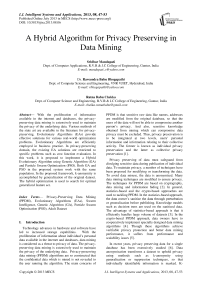A Hybrid Algorithm for Privacy Preserving in Data Mining
Автор: Sridhar Mandapati, Raveendra Babu Bhogapathi, Ratna Babu Chekka
Журнал: International Journal of Intelligent Systems and Applications(IJISA) @ijisa
Статья в выпуске: 8 vol.5, 2013 года.
Бесплатный доступ
With the proliferation of information available in the internet and databases, the privacy-preserving data mining is extensively used to maintain the privacy of the underlying data. Various methods of the state art are available in the literature for privacy-preserving. Evolutionary Algorithms (EAs) provide effective solutions for various real-world optimization problems. Evolutionary Algorithms are efficiently employed in business practice. In privacy-preserving domain, the existing EA solutions are restricted to specific problems such as cost function evaluation. In this work, it is proposed to implement a Hybrid Evolutionary Algorithm using Genetic Algorithm (GA) and Particle Swarm Optimization (PSO). Both GA and PSO in the proposed system work with the same population. In the proposed framework, k-anonymity is accomplished by generalization of the original dataset. The hybrid optimization is used to search for optimal generalized feature set.
Privacy-Preserving Data Mining (PPDM), Evolutionary Algorithms (EAs), Swarm Intelligence, Genetic Algorithm (GA), Particle Swarm Optimization (PSO), Adult Dataset
Короткий адрес: https://sciup.org/15010453
IDR: 15010453
Список литературы A Hybrid Algorithm for Privacy Preserving in Data Mining
- Xinjing Ge and Jianming Zhu, (2011), Privacy Preserving Data Mining, New Fundamental Technologies in Data Mining.
- Agrawal R., Srikant R. Privacy-Preserving Data Mining. Proceedings of the ACM SIGMOD Conference, 2000.
- Malin, B., Benitez, K., & Masys, D. (2011). Never too old for anonymity: a statistical standard for demographic data sharing via the HIPAA Privacy Rule. Journal of the American Medical Informatics Association, 18(1), 3-10.
- Singh, M. D., Krishna, P. R., & Saxena, A. (2010, January). A cryptography based privacy preserving solution to mine cloud data. In Proceedings of the Third Annual ACM Bangalore Conference (p. 14). ACM.
- Patrick Sharkey, Hongwei Tian, Weining Zhang, and Shouhuai Xu, 2008, Privacy-Preserving Data Mining through Knowledge Model Sharing, Springer-Verlag Berlin Heidelberg, pp. 97–115, 2008
- Pawel Jurczyk, Li Xiong, 2008, Privacy-Preserving Data Publishing for Horizontally Partitioned Databases, CIKM’08, October 26–30USA., ACM 978-1-59593-991-3/08/10.
- Campan, A., & Truta, T. (2009). Data and structural k-anonymity in social networks. Privacy, Security, and Trust in KDD, 33-54.
- Nergiz, M. E., Clifton, C., & Nergiz, A. E. (2009). Multirelational k-anonymity. Knowledge and Data Engineering, IEEE Transactions on, 21(8), 1104-1117.
- Stokes, K., & Torra, V. (2012, March). N-Confusion: a generalization of k-anonymity. In Proceedings of the 2012 Joint EDBT/ICDT Workshops (pp. 211-215). ACM.
- Cao, J., Karras, P., Kalnis, P., & Tan, K. L. (2011). SABRE: a Sensitive Attribute Bucketization and REdistribution framework for t-closeness. The VLDB Journal, 20(1), 59-81.
- Shi, P., Xiong, L., & Fung, B. (2010, October). Anonymizing data with quasi-sensitive attribute values. In Proceedings of the 19th ACM international conference on Information and knowledge management (pp. 1389-1392). ACM.
- A. Meyerson, R. Williams, On the complexity of optimal k-anonymity, in: Proc. of the 23rd ACM SIGMOD-SIGCAT-SIGART Symposium, ACM, New York, NY, 2004, pp. 223–228.
- P.Samarati, Protecting respondents’ identities in microdata release, IEEE Transactions on Knowledge and Data Engineering 13 (6) (2001) 1010–1027.
- Van der Merwe, D., & Engelbrecht, A. P. (2003). Data clustering using particle swarm optimization. In IEEE congress on evolutionary computation (1) (pp. 215–220). New York: IEEE.
- Holden, N., & Freitas, A. (2008). A hybrid PSO/ACO algorithm for discovering classification rules in data mining. Journal of Artificial Evolution and Applications, 2008, 11 pages.
- Van den Bergh F. and Engelbrecht A.P., ‘A Cooperative Approach to Particle Swarm Optimization’, IEEE Transactions on Evolutionary Computation, 2004, pp. 225-239.
- Premalatha, K., & Natarajan, A. M. (2009). Hybrid PSO and GA for global maximization. Int. J. Open Problems Compt. Math, 2(4), 597-608.
- Bayardo R. J., Agrawal R.: Data Privacy through Optimal k-Anonymization. Proceedings of the ICDE Conference, pp. 217–228, 2005.
- Sakuma, J., & Kobayashi, S. (2007, July). A genetic algorithm for privacy preserving combinatorial optimization. In Proceedings of the 9th annual conference on Genetic and evolutionary computation (pp. 1372-1379). ACM.
- Dehkordi, M. N., Badie, K., & Zadeh, A. K. (2009). A novel method for privacy preserving in association rule mining based on genetic algorithms. Journal of software, 4(6), 555-562.
- Matatov, N., Rokach, L., & Maimon, O. (2010). Privacy-preserving data mining: A feature set partitioning approach. Information Sciences, 180(14), 2696-2720.
- P. Samarati and L. Sweeney. Protecting privacy when disclosing information: k-anonymity and its enforcement through generalization and suppression. Technical report, CMU, SRI, 1998.
- Lefevre, K., Dewitt, D., And Ramakrishnan, R. 2005. Incognito: Efficient full domain k-anonymity. In SIGMOD.
- Zhong, S., Yang, Z., And Wright, R. N. 2005. Privacy-enhancing k-anonymization of customer data. In Proceedings of the International Conference on Principles of Data Systems (PODS).
- L. David, Handbook of Genetic Algorithms. New York: Van Nostrand Reinhold. 1991.
- D.E. Goldberg, Genetic Algorithms: in Search, Optimization, and Machine Learning. New York: Addison-Wesley Publishing Co. Inc. 1989.
- Qing Cao, Tian He, and Tarek Abdelzaher, uCast: Unified Connectionless Multicast for Energy Efficient Content Distribution in Sensor Networks, IEEE Transactions On Parallel And Distributed Systems, Vol. 18, No. 2, February 2007
- Latiff, N.M.A.; Tsimenidis, C.C.; Sharif, B.S., "Performance Comparison of Optimization Algorithms for Clustering in Wireless Sensor Networks," Mobile Adhoc and Sensor Systems, 2007. MASS 2007. IEEE International Conference on , vol., no., pp.1-4, 8-11 Oct. 2007
- Matthew Settles,” An Introduction to Particle Swarm Optimization”, 2005
- Eberhart, R. C., Shi, Y.: Particle swarm optimization: Developments, applications and resources, In Proceedings of IEEE International Conference on Evolutionary Computation, vol. 1 (2001), 81-86.
- El-Abd, M., & Kamel, M. (2005). A taxonomy of cooperative search algorithms. Hybrid Metaheuristics, 902-902.


